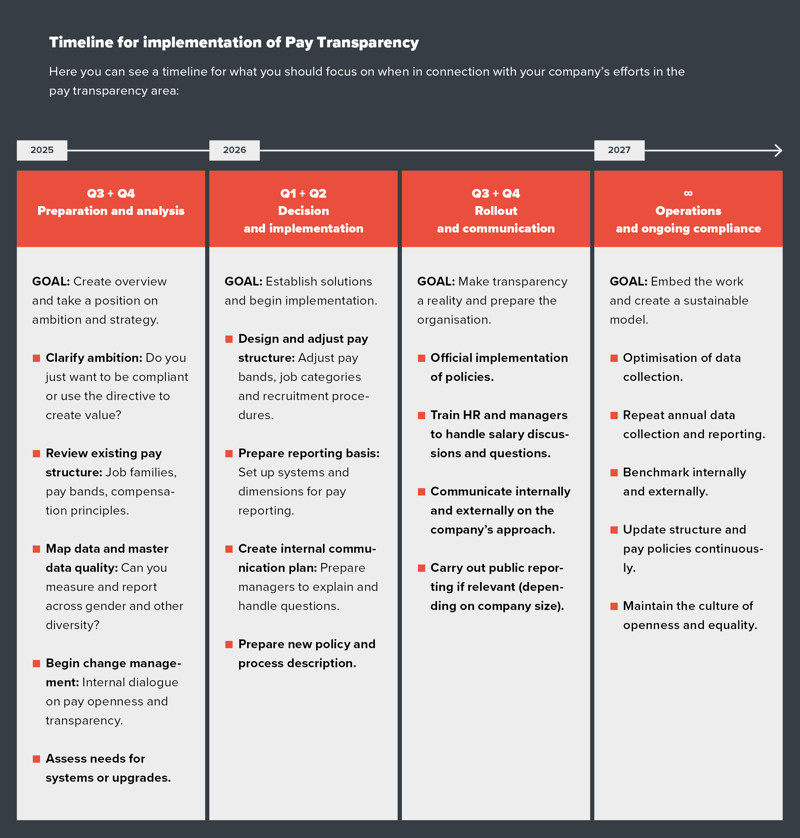When the EU's pay transparency directive comes into force in summer 2026, companies will not only need to deliver on reporting and compliance. They will also need to handle a cultural change in the way we talk about salary. We have asked partner at Basico and pay expert Henrik Schøtt Kjærgaard what it takes to be ready – and we can reveal that it places significant demands across systems, processes and throughout the organisation.
By June 2026, all EU countries must have implemented the pay transparency directive. This is a political decision that builds on decades of equality initiatives and growing recognition that unequal pay is still a real challenge across gender and other diversity.
The directive places requirements on recruitment processes, internal pay structures and companies' ability to report openly and systematically about pay. And it touches something fundamental: How we talk about salary.
Therefore, CFOs, HR directors and compliance officers should already now actively consider what the directive will mean for their organisation.
In this article, we pose 11 important questions about the directive's significance for Danish companies to our partner and pay expert Henrik Schøtt Kjærgaard, who gives you the necessary overview of the change process, and what you as a company can advantageously focus on in relation to preparation, implementation, rollout and operation.
What are the most important elements of the upcoming EU directive?
Fundamentally, it is – like many other directives we have seen recently, such as GDPR and time registration – a directive that has been created to protect employees. Here specifically their pay, and especially with a focus on equality in the pay area.
This will have implications in several areas. Firstly, there will be requirements for transparency in the recruitment process – how we talk about pay, and what information employees can gain access to. This will change the dialogue about pay.
There will also be increased focus on how companies internally organise employees – how job categories and competency levels are defined, and how it all connects with the pay that is disbursed.
It will be as much a cultural change as it will be a structural and technical exercise.
What challenges do you see for companies in relation to getting ready for the directive?
The first – and perhaps biggest – challenge is the change management that comes with it. That is, understanding that pay is something we will talk about differently in the future.
And the second challenge – which perhaps is actually the most fundamental – is more structural: How you as a company organise your workforce. What do you call your employees?
What job families and competency levels do you work with? How do you organise it so you can use it to create transparency?
Afterwards comes, of course, the whole technical exercise: How you actually do it. But before that, you need to make a lot of decisions in the preparation phase.
And when we know that seven to eight out of ten large companies are still struggling with the quality of their master data, there is a task in getting that sorted out. Get control of basic data, clarify whether there is a need to add new dimensions to be able to report on what is required.
Employees gain access to this information in the recruitment process:
Information about starting salary or salary range:
In job advertisements or before salary negotiations, companies must provide information about the starting salary or expected salary range for the position.
No questions about salary history:
Companies may not ask about a candidate's previous salary or salary history during the recruitment process.
Clarity about salary conditions:
Information about salary must be based on objective and gender-neutral criteria.
So data and structure first – and then technology afterwards?
Yes, exactly. It's probably less important initially whether it's solved in existing systems, with manual processes or by investing in new systems. That comes afterwards.
What's important are the central decisions you make in your preparation.
But you can still start preparing your organisation now. Especially regarding what it will mean for your recruitment process – because that needs to be rethought, for example in relation to salary conditions now becoming part of an initial dialogue with candidates.
And I think it's a good idea to have a gradual implementation – so it doesn't just become something you start up the day the law comes into force.
What should companies ask themselves to get off to a good start with the preparation?
They need to ask themselves fundamentally: What is the ambition? What do we want to achieve with this directive? Do we just want to meet the minimum requirements, or will we use it as an opportunity to do something more? And what is it then that we want to achieve with it? This is quite crucial for how a company should approach this directive.
And then they need to ask themselves: Will we anchor it centrally or decentrally? Because this has enormous significance for how you design your processes. Who may answer what? Should managers around the organisation be able to answer, or should it be something that is handled centrally?
Because it may not work if managers get a question and answer something they shouldn't say anything about. It's very much about how you choose to control it – and there isn't necessarily a right and wrong answer. It also depends on the company's culture, and how they choose to manage the directive in practice.
Is there a difference in how the directive will make a difference for large and small companies respectively?
For small companies – let's say under 500 employees – there are typically fewer support functions. This means that it may not be professional HR people who handle recruitment, but managers out in the business. And this can be a challenge, because then they also need to understand and handle the new requirements.
In large companies, they typically have dedicated recruitment people and HR partners, and this can make the rollout more efficient. But on the other hand, there are also more structures, more data and more complexity that the company needs to adapt.
So these are two different challenges – not necessarily easier in one place than the other. The large companies are already well underway in many places, but it's probably among the small and medium-sized companies that the change will be greatest, because their starting point is different.
What legal and compliance challenges might companies encounter?
Yes, that's also a significant angle. One thing is how you design the structure – another is how you ensure that you don't create unintended transparency.
A risk could be building a system that actually exposes individuals. That is, where you can work out who earns what – and that's not the directive's purpose.
So there's also a balance: You need sufficient structure to create transparency, but it mustn't become too complex, and it mustn't become too personal either.
Is that a real risk – that the system becomes too complex?
Yes, and that's actually quite a significant risk. If you have too many parallel structures – for example, both your HR structure, your financial cost centre structures and a new transparency structure – then it can become difficult to maintain and comprehend.
You risk that everything makes sense in isolation, but collectively it becomes unwieldy and cumbersome to operate.
So how to keep it simple – but still good enough to be transparent – that's one of the points that will become very topical for most companies over the next year or so.
It sounds as though a large part of the preparation is also about change management?
Yes, absolutely. This directive perhaps calls more for change management than for classic system and structural adaptation. Because it's fundamentally about changing the way we talk about pay.
In many companies, talking about pay in the canteen is almost grounds for dismissal. That's obviously not what the directive encourages – it's not about us standing around exchanging payslips by the coffee machine. But it is about us being able to talk openly about pay levels and equality in a way that's legitimate and accepted.
This means that what previously happened in secret – the pay talk that exists anyway – is now being lifted into a legitimate space. And that requires some adjustment, from both management and employees.
But it's going to be a long haul, because it's about culture and about changing habits. It's also about getting everyone to understand that it's acceptable to talk about pay – not necessarily what individuals earn, but more about the structure and transparency in it.
So it's not just about being compliant – the company can also use it actively?
Precisely. It's about activating transparency – instead of just being reactive and waiting for someone to ask, companies can be proactive and show the way themselves.
This can, for example, play into employer branding, trust and recruitment.
But with that naturally comes some requirements as well. The more you want to achieve, the more you also need to be prepared to work with structure, data and change management. It's not just something you tick off in a system.
And in that way it could even become a competitive parameter?
Yes, very much so. That's also an interesting angle. The small companies will – in order to attract employees – probably have to live up to the same expectations. Simply because candidates in the future will have an expectation of transparency regardless of the company's size.
So in that way it becomes a competitive advantage to be ahead. And it's also clear that for many employees an expectation that pay transparency is something that benefits them has already emerged.
I actually think there will be a demand that almost goes beyond what the directive requires. The directive sets a baseline – but the market can quite easily pull companies further.
How will this become part of future workplaces and HR strategies?
I actually think it will become quite concrete. Until now, companies have tried to create transparency with their own concepts and structures – and that has made it difficult to benchmark and compare.
Now there's a framework coming. So if you lean into it and get an ambition defined, then you can use it for something meaningful.
That's also what we want to help companies with: Finding the ambition and helping to set a direction. Then it's also easier afterwards to help with the actual implementation.

Timeline for implementation of Pay Transparency

Are you prepared?
Would you like us to help you meet the future in the pay area, so that Pay Transparency can become an active, value-creating element in your organisation? Then reach out to us for an informal chat.

 en
en
 da
da


